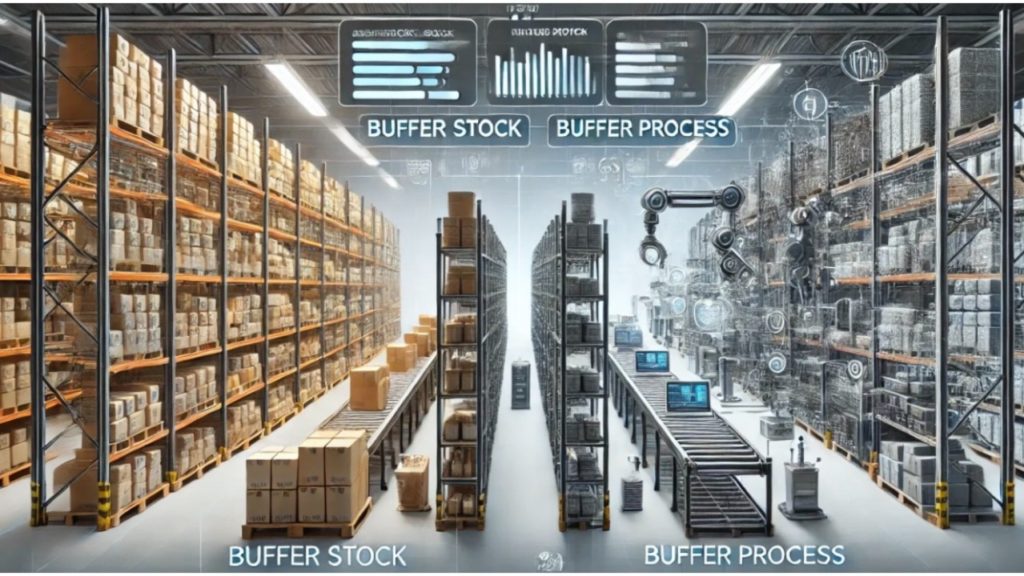Buffering Inventory vs. Buffering Process in ERP Implementation

I recently came across an interesting thought shared by an old friend of mine, someone who’s a co-founder and leader in the retail industry. He said, “Instead of hoarding stock to ‘buffer’ quality, buffer the process itself.“
At first, I was surprised. For as long as I can remember, most industries, especially manufacturing, distribution, and retail, have always kept extra stock to buffer against demand fluctuations, avoid shortages, and prevent backlogs in operations as standard practice to keep things running smoothly and buffering the process is a big change which is not a easy task to do so to keep the things simple, it is always easy to rely on stockpile rather than buffering processes.
The more I thought about it, the more I realised that any ERP solutions (like Infor LNCE) help businesses to shift away from relying on excess inventory and focus more on streamlining and balancing processes. Of course, this shift cannot be done magically; it requires additional effort and dedication. However, an ERP system can help make this transition less hectic. This raised an important question: If reducing reliance on stockpiling is beneficial, why do some industries still depend on it while others avoid it entirely?
Not Every Industry Stockpiles Inventory
Stockpiling inventory is standard in many industries, but not all businesses follow this approach. Those who do have different reasons behind it, such as:
- Keeping extra stock to replace defective items due to quality issues.
- Ordering in bulk to avoid delays from supply lead times.
- Stockpiling to prevent running out of products during unexpected demand spikes.
- Producing more than needed to avoid inefficiencies or cut costs.
On the other hand, industries like on-demand manufacturing or high-tech face different challenges, they can’t afford to stockpile because products may expire or become outdated. Still, they face the same challenge of maintaining quality and smooth operations without adding unnecessary costs.
Stockpiling Inventory – Pros and Cons
Advantages
- Acts as a safety net for quality issues or supplier delays.
- Keeps production running, even in uncertain markets.
- Can lead to bulk purchase discounts.
Downsides
- Ties up working capital that could be used elsewhere.
- Increases costs for storage, insurance, and maintenance.
- Risks waste or outdated stock, especially in fast-changing industries.
- Masks process inefficiencies rather than solving them.
While stockpiling has its advantages, it also comes with challenges. The key to successfully reducing dependency on excess inventory is a gradual, structured approach, adopting changes in phases rather than an abrupt shift. This way, industries can maintain stability while progressively optimizing their processes.
Phase 1: Inventory Management During ERP Implementation
Implementing an ERP system like Infor LNCE is a big shift. While it brings long-term efficiency, businesses need to manage inventory carefully during the transition.
Cycle Counts & Buffer Stock Management
- Conduct cycle counts before go-live to ensure inventory accuracy.
- Keep buffer stock to ensure smooth operations while teams adjust to new workflows and automation.
- Some industries—like automotive, aerospace, and food & beverage—have strict inventory control needs for safety and compliance, so buffer stock is essential.
Why Start with Buffer Stock?
- Provides stability while adapting to new ERP processes.
- Meets industry regulations requiring predefined safety stock levels.
- Ensures smooth operations during the transition phase.
However, buffer stock should not become a long-term solution. While it provides short-term stability, relying on it for too long leads to high storage costs, block the capital, and hidden inefficiencies. To create a sustainable and more affordable solution, businesses must gradually shift towards process buffering, using technology to improve supply chain efficiency rather than just stock levels.
Phase 2: Shifting to Process Buffering with ERP
Once the ERP system is stable and running, businesses can shift from relying on excess inventory to optimizing their processes. With LNCE’s advanced features, companies can build a more agile and responsive supply chain.
How LNCE Supports Process Buffering
- Real-Time Inventory Tracking – Instead of overstocking, businesses use live data for more precise inventory control.
- Automated Replenishment – Orders stock as needed (JIT), not just in case (JIC).
- Planning & Scheduling – Optimizes production to reduce excess inventory.
- Supplier Collaboration & Visibility – With integrated systems, businesses work closely with suppliers to avoid last-minute stockpiling.
These features allow companies to reduce unnecessary inventory while ensuring smooth, efficient operations and maintaining quality.
Balancing Inventory & Process Buffering
During ERP Implementation:
- Count inventory and keep a backup stock for a smoother transition.
- Give teams time to adjust to new ERP processes and automation.
After ERP is Stable:
- Shift gradually to process buffering, using real-time data, production scheduling, and automated ordering process.
- Cut back on excess inventory while ensuring operations stay efficient and compliant.
Final Thought: Aligning Inventory with ERP
ERP is not just about implementing AI, digitalizing dashboards or modern look of outdated workflows; it’s about rethinking and redesigning how businesses operate. While keeping extra stock may seem like a safe bet, focusing on improving processes leads to long-term savings and better efficiency.
So, what do you think? Is it better to rely on buffering inventory to manage challenges, or focus on buffering processes to improve operations?
We would love to hear your thoughts! Have you faced similar challenges in ERP or supply chain transformations? Please comment!
Written by Amit Kumar
March 10, 2025